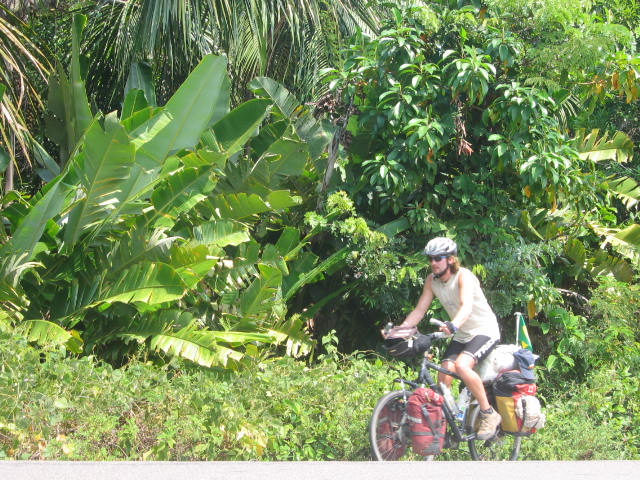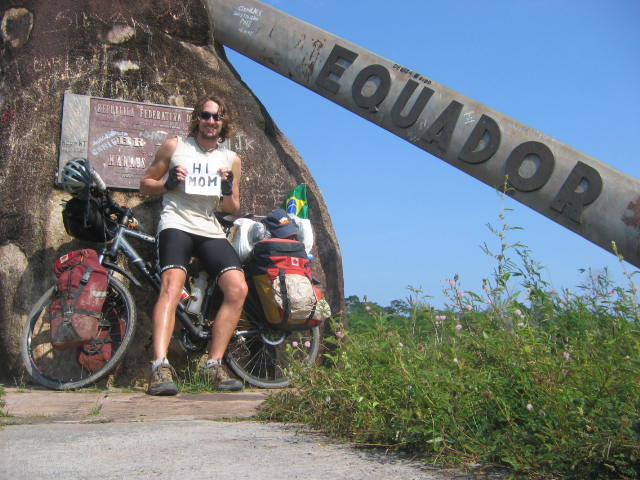Please visit Ryan Parton Writing Solutions, Comox Valley copy writer
The following are stories written for the Selkirk Journal and the Comox Valley Record during my 11-month bicycle expedition through South America, from January to November, 2004:
Border Bound (a pre-trip introduction)
Against the Wind Through Tierra del Fuego
Hurry Up and Slow Down (cycling in Patagonia)
Chugging Through Chile (cycling Chile's Carretera Austral)
Argentina a Lot Like Canada (crossing the Argentina pampas)
South America's Hidden Gem (travels in Uruguay)
The Bolivian Paradox
Pushing Through Peru (misadventures on a Peruvian riverboat)
Jungle Journey a Drag (cycling the Brazilian Amazon
Grand Finale (cycling Venezuela)
Back to my writing samples
Back to Atravesando Fronteras home page

 Jungle Journey a Drag
Jungle Journey a Drag
by Ryan Parton
The Amazon. Few places on earth inspire the same sense of awe, invoke the same vivid images of savage wilderness, with the mere drop of a name. Its numbers alone are staggering: The Amazon Basin covers nearly 5 million square kilometres, is home to a quarter of all plant life found on earth and contains more fresh water than all the rivers in Europe combined, and yet the simple fact that I was able to ride my bike through its midst is symptomatic of its steady decline.
The BR-174 is one of several highways carved into the Brazilian Amazon like garish asphalt scars. Although it stretches nearly 1,000 kilometres through the heart of northern Amazonia, what I saw while cycling its length was a far cry from the romantic images of untamed jungle that I`d naively envisioned.
My journey began in Manaus, a modern city of 1.5 million people in the middle of the Brazilian Amazon. Once free of Manausī extensive urban sprawl, the BR-174 begins its trajectory north toward the Venezuelan border, the forest looming closely on either side. A rolling ribbon of asphalt slicing through the jungle, the BR-174 seemed the perfect harmony of nature and modernization, or so I tried to believe, until a huge, flattened snake at the side of the road reminded me of the impact that this highway has had on its environment.
Although the BR-174 is lined with all sorts of exotic roadkill, the Amazonīs animals weren`t the only ones adversely affected by the advent of a busy highway passing through their midst. A 125-kilometre stretch of the BR-174 cuts through the vast territory of Brazil`s Waimiri Atroari Indians, who were none to pleased with the encroachment. More than 200 Brazilian soldiers were killed with poisoned arrows during the highway`s construction in the 1970s, but the conflict turned out to be much more devastating to the Indians themselves. From a population numbering in the thousands, the Waimiri Atroari were reduced to a mere 374 souls by 1987.
Unfortunately, however, the plight of the Waimiri Atroari isn`t unique in the Brazilian Amazon, where more than 75 indigenous tribes have gone extinct in the 20th century alone, most killed off by exposure to new diseases against which they had no natural defenses. Many of these diseases were introduced via more than 10,000 kilometres of new roads built over a 15-year period in the mid-1900s, part of an aggressive campaign by the Brazilian government to colonize the Amazon.
 Today, the Waimiri Atroari territory is a protected indigenous reserve, through which passage is strictly regulated. As such, it is forbidden to enter by bicycle, and so I caught a lift with a friendly Brazilian trucker to a small hotel north of the reserve. Back on my bike, I was disappointed to see that the landscape along the BR-174 had lost all semblance of the mighty rainforest which it must once have been. North of the reserve, the highway is flanked with ugly tracts of cleared land, speckled with lonely palm trees in a weak sort of tribute to the forestīs former glory. Where once jaguars prowled and monkeys swung through the canopy were now herds upon herds of the new kings of the jungle: Cattle.
Today, the Waimiri Atroari territory is a protected indigenous reserve, through which passage is strictly regulated. As such, it is forbidden to enter by bicycle, and so I caught a lift with a friendly Brazilian trucker to a small hotel north of the reserve. Back on my bike, I was disappointed to see that the landscape along the BR-174 had lost all semblance of the mighty rainforest which it must once have been. North of the reserve, the highway is flanked with ugly tracts of cleared land, speckled with lonely palm trees in a weak sort of tribute to the forestīs former glory. Where once jaguars prowled and monkeys swung through the canopy were now herds upon herds of the new kings of the jungle: Cattle.
In the last 15 years, the number of cattle in the Amazon has more than doubled to nearly 60 million, more than in Canada and Australia combined. According to some estimates, as many as 20,000 square kilometres of tropical rainforest are cleared every year to create grazing land, making cattle ranching the leading cause of rainforest destruction.
The destruction of the rainforest, while expediting the buildup of harmful greenhouse gasses in the atmosphere, is far from simply an environmental issue. At least a quarter of prescription drugs in North America are derived from plants, yet less than five per cent of the world`s tropical plant species have been analyzed for their therapeutic potential. In the Amazon, where one hectare of forest can contain more than 1,000 species of plants, and where species tend to develop especially potent toxins to survive in such a competitive ecosystem, the estimated 15 per cent of Amazonian rainforest already destroyed represents the permanent loss of thousands of potential life-saving medicines.
Despite the disheartening view from the BR-174, it`s not all bad news for the Amazon. Numerous conservation groups are working to promote sustainable economic activities, such as fruit and nut cultivation, as viable alternatives to cattle ranching, and the Brazilian government has taken steps in the right direction by creating new protected areas within the rainforest. Likewise, by the beginning of this year, the population of the Waimiri Atroari had bounced back to 1,018, thanks in part to increased availability of medical services and vigilant protection of their territorial boundaries.
The wild, romantic version of the Amazon that Iīd so keenly envisioned does exist, deep in the jungle beyond the destructive reach of industrialization. With any luck it will continue to exist, and youīll never be able to get there by bicycle.
To learn more about conservation efforts in the Amazon, visit www.amazonconservation.org.

Next
Previous
Border Bound (a pre-trip introduction)
Against the Wind Through Tierra del Fuego
Hurry Up and Slow Down (cycling in Patagonia)
Chugging Through Chile (cycling Chile's Carretera Austral)
Argentina a Lot Like Canada (crossing the Argentina pampas)
South America's Hidden Gem (travels in Uruguay)
The Bolivian Paradox
Pushing Through Peru (misadventures on a Peruvian riverboat)
Jungle Journey a Drag (cycling the Brazilian Amazon
Grand Finale (cycling Venezuela)
Back to my writing samples
Back to Atravesando Fronteras home page
 Today, the Waimiri Atroari territory is a protected indigenous reserve, through which passage is strictly regulated. As such, it is forbidden to enter by bicycle, and so I caught a lift with a friendly Brazilian trucker to a small hotel north of the reserve. Back on my bike, I was disappointed to see that the landscape along the BR-174 had lost all semblance of the mighty rainforest which it must once have been. North of the reserve, the highway is flanked with ugly tracts of cleared land, speckled with lonely palm trees in a weak sort of tribute to the forestīs former glory. Where once jaguars prowled and monkeys swung through the canopy were now herds upon herds of the new kings of the jungle: Cattle.
Today, the Waimiri Atroari territory is a protected indigenous reserve, through which passage is strictly regulated. As such, it is forbidden to enter by bicycle, and so I caught a lift with a friendly Brazilian trucker to a small hotel north of the reserve. Back on my bike, I was disappointed to see that the landscape along the BR-174 had lost all semblance of the mighty rainforest which it must once have been. North of the reserve, the highway is flanked with ugly tracts of cleared land, speckled with lonely palm trees in a weak sort of tribute to the forestīs former glory. Where once jaguars prowled and monkeys swung through the canopy were now herds upon herds of the new kings of the jungle: Cattle. Jungle Journey a Drag
Jungle Journey a Drag